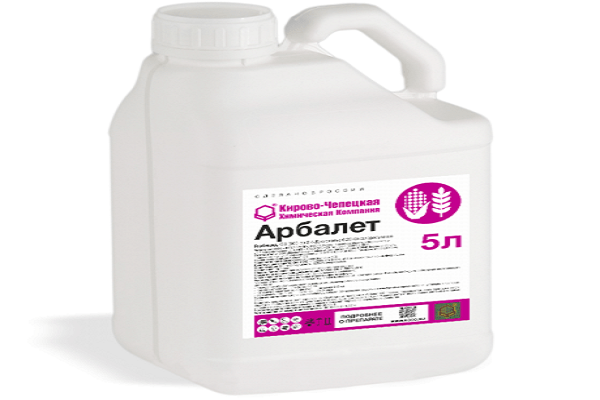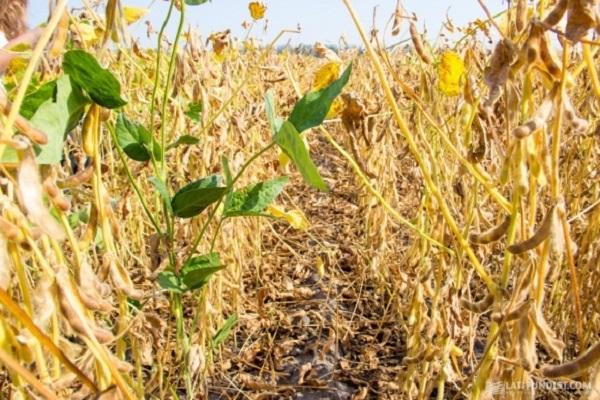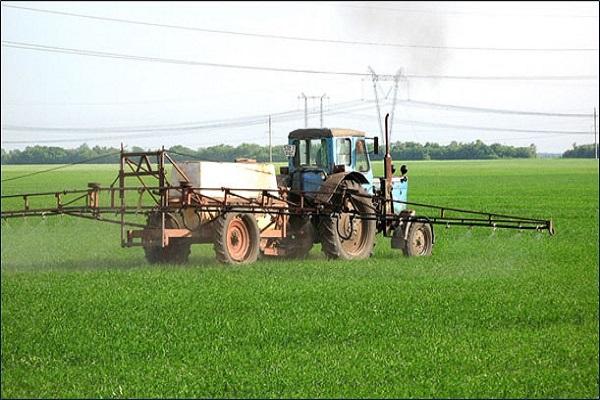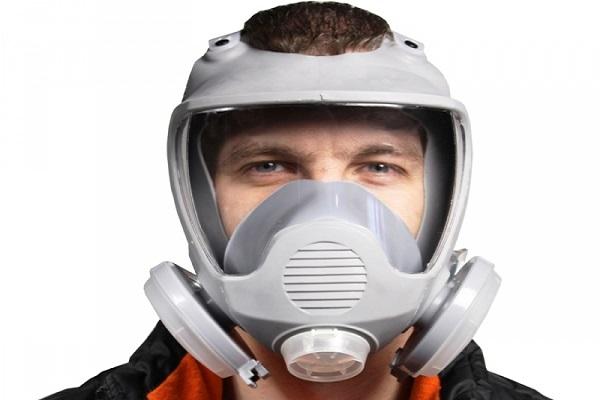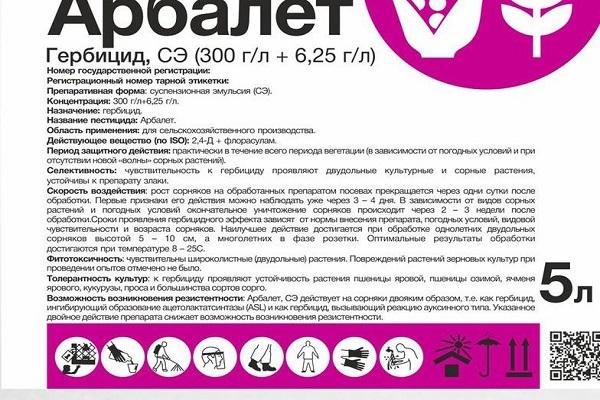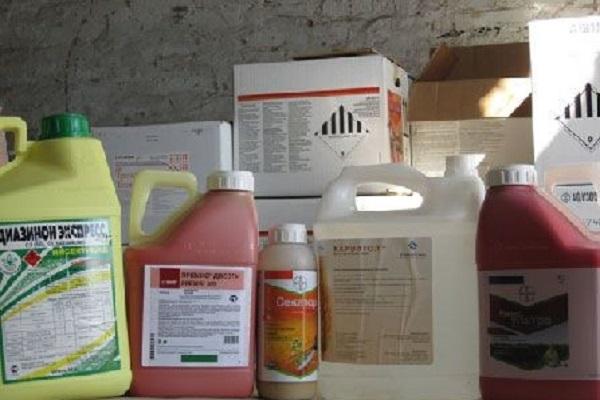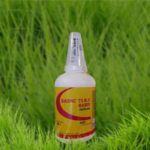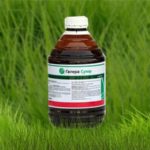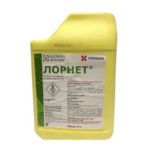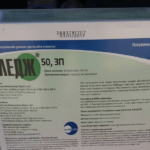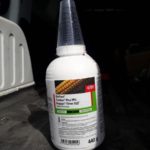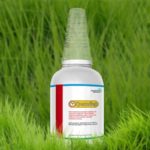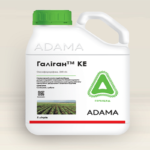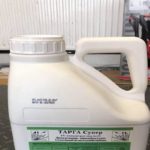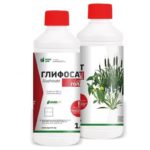The two-component selective herbicide Crossbow is used to control annual and perennial dicotyledonous weeds. The drug protects grain crops from weeds for the entire growing season. The herbicide is used for post-emergence treatment. The herbicidal agent Crossbow acts by contact and remains in the soil.
- Composition, purpose and release form of the herbicide Crossbow
- How the product works
- Advantages and disadvantages
- Consumption rate of the drug
- How to prepare the working mixture?
- Instructions for use of the herbicide Crossbow
- Precautionary rules when working with the product
- First aid measures
- Degree of toxicity
- Is it compatible with other products?
- Storage conditions and periods
- Analogs
Composition, purpose and release form of the herbicide Crossbow
The herbicide is used to destroy annual and perennial dicotyledonous weeds that interfere with the normal growth and development of grain crops. The drug Arbalet has the form of a suspension emulsion. Before use, the product is diluted with water in the dosages specified in the instructions.
This herbicide contains two components: 2,4-D (2-ethylhexyl ether) and florasulam. The drug is produced by the Kirovo-Chepetsk Chemical Company. The herbicide is sold in 5 liter plastic canisters.
How the product works
Active components penetrate into weeds through leaves and roots. The herbicide begins to act 3-4 hours after irrigating the field. Once inside the plant, the active components at the cellular level inhibit the formation of enzymes, stopping the growth and development of weeds.
The first signs of chlorosis, necrosis, and wilting are noticeable after 3-4 days. Complete destruction of weeds occurs 2-3 weeks after irrigating the field with a herbicide.
Advantages and disadvantages
Advantages of using the drug Crossbow:
- complete destruction of weeds in one spraying;
- long period of protection;
- fights young and overgrown weeds.
Disadvantages of the herbicide:
- used at temperatures from +8 to +25 degrees;
- Do not use during rainfall or on weakened main crops.
Consumption rate of the drug
The crossbow is used in the following dosages (at a working fluid consumption of 200-290 l/ha):
- For wheat, rye, barley: 0.39-0.58 l/ha.
- For corn: 0.41-0.52-0.59 l/ha.
How to prepare the working mixture?
The herbicidal solution is prepared from water and the drug on the day of spraying the field. Tractor sprayers are used for irrigation.Before use, the herbicide must be mixed while it is in its original packaging. Then the sprayer tank is filled 1/3 with clean, free water.
With the mixers turned on, pour in the amount of herbicide measured for one filling of the sprayer. The mixture is mixed well, then water is added to the required volume and the mixers are turned on again.
Instructions for use of the herbicide Crossbow
A herbicide diluted with water is used for post-emergence treatment of main crops. Winter crops are sprayed in the spring. Weeds are destroyed in the early stages of development. The main crop should be in the phase of 3-5 true leaves or in the tillering period - emerging into the tube.
Irrigation of the field is carried out under favorable weather conditions (lack of precipitation, wind, air temperature from +8 to +25 degrees Celsius).
Spraying is not done if the main crop is under stress due to frost, drought, lack of nutrients, disease, or insect damage.
Precautionary rules when working with the product
Persons over 18 years of age who have no medical contraindications are allowed to work with the herbicide composition. When carrying out field work, the worker must wear a protective suit, mask or respirator, boots and rubber gloves. After contact with the herbicide composition, it is recommended to wash your face and hands with soap and water and rinse your mouth with a soda solution.
First aid measures
The herbicidal preparation must not be drunk, inhaled, or used for other purposes. If a chemical gets into your eyes, rinse with clean running water.If drops of herbicide get on the skin, they should be dipped with a rag and then washed with soap and water.
If the herbicide gets into the stomach, you need to induce vomiting (let the person drink a couple of glasses of warm water with activated carbon or other sorbent and press on the back wall of the throat). If you inhale chemical vapors, a person should be removed from the area of herbicide contamination, allowed to breathe fresh air and given warm water or tea.
If serious signs of poisoning appear, you must call an ambulance.
Degree of toxicity
The drug Crossbow has been assigned hazard classes 2 and 3. The herbicide is not toxic to humans, animals, birds, fish, and insects. If the dosage specified in the instructions is followed, it does not exhibit phytotoxicity. Spraying the field is not recommended during the active summer of bees. The use of the pesticide is prohibited in environmental protection areas.
Is it compatible with other products?
The two-component pesticide Crossbow can be used in conjunction with isoproturon-based herbicides. Complex use of herbicide, insecticide and fungicide preparations in tank mixtures is allowed. The use of chemicals based on fenoxaprop and clodinafop together with the Crossbow is prohibited. Before use, it is recommended to check all drugs for compatibility.
Storage conditions and periods
The drug Crossbow is stored in a warehouse specially designed for pesticides. The warehouse must comply with the requirements of regulations, sanitary and fire safety standards. It is prohibited to store the herbicide in the same room as food or goods.
The drug Crossbow must be completely used before the expiration date.The date of manufacture is indicated on the label or packaging. The shelf life is 3 years. The drug is stored undiluted, in tightly closed and undamaged original packaging.
Analogs
The herbicide Crossbow has analogues with a similar composition and principle of action. These are pesticides Ballerina, Primadonna, Prima. Each of these chemicals has a two-component composition and is used to protect cereals from dicotyledonous weeds.

